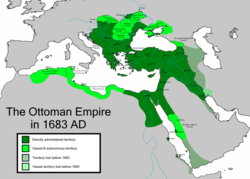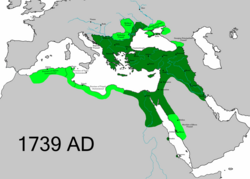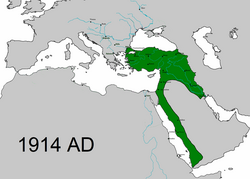Office of the caliphate خلافت مقامى Hilâfet makamı | |||||||
|---|---|---|---|---|---|---|---|
| 1517–1924 | |||||||
| Capital | Constantinople | ||||||
| Working languages | Ottoman Turkish (dynastic) Arabic (religious) | ||||||
| Religion | Sunni Islam | ||||||
| Government | Hereditary caliphate under an empire (1517–1922) Elective caliphate under a parliament (1922–1924) | ||||||
| Caliph | |||||||
• 1517–1520 | Selim I (first) | ||||||
• 1922–1924 | Abdulmejid II (last) | ||||||
| Established | |||||||
• Al-Mutawakkil III formally surrenders his title over to Selim I | 1517 | ||||||
| 1774 | |||||||
| 1914 | |||||||
| 1924 | |||||||
| |||||||
| Caliphate خِلافة |
|---|
 |
|
|
The caliphate of the Ottoman Empire (Ottoman Turkish: خلافت مقامى, romanized: hilâfet makamı, lit. 'office of the caliphate') was the claim of the heads of the Turkish Ottoman dynasty to be the caliphs of Islam in the late medieval and early modern era. During the period of Ottoman expansion, Ottoman rulers claimed caliphal authority after the conquest of Mamluk Egypt by sultan Selim I in 1517 and the abolition of the Mamluk-controlled Abbasid Caliphate. This left Selim as the Defender of the Holy Cities of Mecca and Medina and strengthened the Ottoman claim to leadership in the Muslim world.
The demise of the Ottoman Caliphate took place because of a slow erosion of power in relation to Western Europe, and because of the end of the Ottoman state as a consequence of the partitioning of the Ottoman Empire by the League of Nations mandate. Abdulmejid II, the last Ottoman caliph, held his caliphal position for a couple of years after the partitioning, but with Mustafa Kemal Pasha's secular reforms and the subsequent exile of the imperial Osmanoğlu family from Turkey in 1924, the caliphal position was abolished. Mustafa Kemal Pasha offered the caliphate to Ahmed Sharif as-Senussi, on the condition that he reside outside Turkey; Senussi declined the offer and confirmed his support for Abdulmejid II.[1]
With the establishments of Sufi orders like the Bayramiyya and Mawlawiyya under the Ottoman Caliphate, the mystical side of Islam, Sufism, flourished.[2][3][4][5]
- ^ Özoğlu 2011, p. 5; Özoğlu quotes 867.00/1801: Mark Lambert Bristol on 19 August 1924.
- ^ Algar, Ayla Esen (January 1992). The Dervish Lodge: Architecture, Art, and Sufism in Ottoman Turkey. University of California Press. ISBN 9780520070608.
- ^ Sirriyeh, Elizabeth (2005). Sufi Visionary of Ottoman Damascus: ʻAbd Al-Ghanī Al-Nābulusī, 1641-1731. Psychology Press. ISBN 9780415341653.
- ^ Wasserstein, David J.; Ayalon, Ami (17 June 2013). Mamluks and Ottomans: Studies in Honour of Michael Winter. Routledge. ISBN 9781136579172.
- ^ ́Goston, Ga ́bor A.; Masters, Bruce Alan (21 May 2010). Encyclopedia of the Ottoman Empire. Infobase. ISBN 9781438110257.





